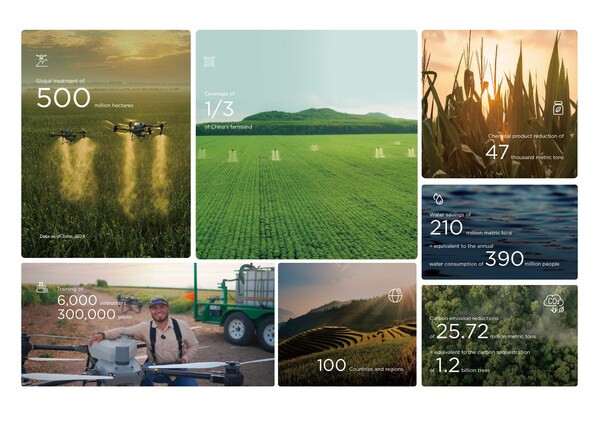Over 300,000 drones operate globally, treating more than 500 million hectares of farmland around the world.
SHENZHEN, China, July 10, 2024 /PRNewswire/ — DJI Agriculture, a global leader in facilitating agricultural innovation through drone technology, unveils its Agriculture Drone Industry Insight Report (2023/2024), showcasing a booming global agricultural drone industry in 2023. Covering policy initiatives and emerging drone applications, the report offers a comprehensive overview to navigate the evolving landscape of agricultural drone technology for 2023/2024.
“DJI Agriculture aims to boost farmland management efficiency by leveraging digital solutions and intelligent drones, all while prioritizing environmental sustainability,” stated Yuan Zhang, Head of Global Sales at DJI Agriculture. “This report highlights that governments and farmers worldwide are embracing agriculture drones and smart farming techniques to enhance food production in a more scientific, sustainable, and eco-friendly manner.”
Key Findings from the 2023/2024 Report
The rapid adoption of agricultural drones worldwide is a testament to the transformative power of emerging technologies in the agricultural sector. By the end of June 2024, agricultural drones have already treated more than 500 million hectares of farmland around the world.
The remarkable efficiency of these drones has led to substantial savings, including a cumulative reduction of 210 million metric tons of water and 47,000 metric tons of pesticides. Furthermore, the implementation of agricultural drones has significantly decreased carbon emissions by 25.72 million metric tons. This reduction is equivalent to the carbon sequestration provided by 1.2 billion trees, underscoring the sustainable and eco-friendly nature of this innovative approach to modern agriculture.
Global Policy Trends
The report notes that governments in several countries have begun to liberalize regulations. In Brazil, the ANAC amended regulations to only require drone registration and pilot licensing before operations can begin. In the US, the FAA published an approval list of agricultural drones that can be used directly with exemptions. China has issued regulations allowing drone pilots to be trained by manufacturers.
“We are excited about these advancements in regulatory frameworks, as they will help to expand the use of agricultural drones and ultimately benefit farmers worldwide,” said Zhang.
Best Practices
The report also highlights best practices, offering valuable guidance on personnel training, drone technology, agricultural applications, and the integration of agronomy and drones. Farmers can directly refer to this guidance to implement more professional agricultural operations.
Technological Advancements
The report also highlights technological advancements that have contributed to the growth of the agricultural drone industry. The integration of artificial intelligence (Al) has allowed for more precise and efficient data processing and decision-making. Furthermore, developments in sensor technology have improved capabilities in precision agriculture. These advancements have not only increased efficiency but also reduced costs for farmers.
Agricultural Drone Tests and Case Studies
Numerous tests and case studies were documented by DJI Agriculture and its partners in 2023, including:
- Drifting tests for the Agras T50 and T25 models in China, Australia, and Hungary.
- Management of a 10-hectare navel orange orchard through a full growth cycle by a single farmer.
- Herbicide application over agave farms in Mexico, saving 88% water and reducing costs by over $60 USD per hectare.
- Targeted weed spraying in Australian pasture land, saving 50% on costs and reducing chemical usage by 51%.
- Pesticide spraying in a 1,500-tree durian orchard in Thailand, reducing chemical usage by 20-30%.
- Ripener spraying on smallholder sugarcane farms in South Africa, increasing final sugar yields by up to 1.78 tons per hectare.
Conclusion
DJI Agriculture’s annual report highlights significant progress in the agricultural drone industry and paves the way for future advancements. By prioritizing sustainability and innovation, we aim to revolutionize modern agriculture and positively impact global food production. Stay tuned for our next update as we work towards a greener, smarter, and more efficient agricultural future.
The full 2023/2024 report can be accessed here.
For more information on DJI Agriculture please visit our website.
Website: ag.dji.com
Facebook: facebook.com/DJIAgriculture
Twitter: twitter.com/DJIAgriculture
YouTube: youtube.com/@DJIAgriculture
Agave Case Study: https://ag.dji.com/case-studies/agras-t40-t50-agave
Instagram: instagram.com/djiagriculture_official

